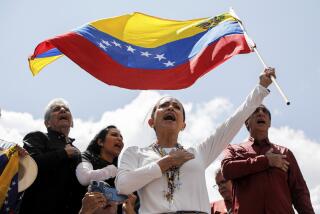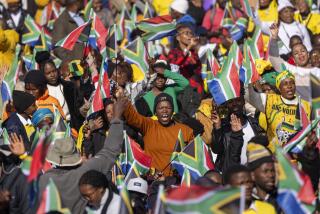At Last, All the Players Are on the Field: Let Play Begin : South Africa: With Mandela’s release, there is more hope--and more danger--than ever. At stake is the creation of a democratic industrial giant.
- Share via
Every now and then something happens that fires the imagination and buoys spirits around the world. The walk to freedom by Nelson R. Mandela from the hot vineyards of the town of Paarl, near Cape Town, is one such occasion.
Like the march to liberty in Eastern Europe, the freedom of the black nationalist leader can affect the world as few events have in recent decades. In essence, what is at stake is the creation of an industrial giant in Southern Africa under workable majority rule.
For 27 years (while Mandela was in prison), this writer has lived near the places where he had been held--Robben Island, from which no prisoner has ever escaped alive, the Pollsmoor complex, situated near the white suburb of Tokai, and, most recently, Victor Verster Prison near the country town of Paarl.
Though silent and unseen, Mandela became a powerful living presence in the community at large. Ironically, he received a life sentence for the sabotage that he planned but did not execute. The longer the government kept him in prison, the more he grew in stature. He was an activist even while behind bars, he was a natural leader among the convicts, he encouraged imprisoned young members of the African National Congress, and he sent messages to individuals and organizations outside prison walls. He became larger than life, although invisible. He emerged from prison on Sunday politically “cleaned”--not having had the opportunity to make the mistakes of free men.
Mandela was released during a delicate moment in South African history. The country stands on the brink of meaningful negotiations, or of frightful new bouts of violence.
The fragile situation can be smashed at any moment by right-wing or radical left-wing violence.
There are encouraging signs, however. The large numbers of white South Africans among the welcoming crowds after Mandela’s released is one. His generous praise of white organizations, such as the brave women of the anti-apartheid Black Sash and the National Union of South African students, shows that he wishes to straddle the racial divide. But he has made it clear that he has not “softened” his views in any way. He is in total agreement with the African National Congress on all matters, including majority rule and the armed struggle. As he returns to his people and prepares for a historic tussle with white power, there is more hope and more danger in South Africa than at any time since he was imprisoned. At age 71, he faces backbreaking work during his remaining time on Earth.
In moving quickly to release him, President Frederik W. de Klerk has been true to his promise of change. He has preempted forces that would see South Africa go up in smoke. De Klerk has thus edged ahead of much mainstream white opinion. He will need all of his leadership skills if he wishes to enter real negotiations with black South Africa. But he has caught the urgency of the times. It seems that only a right-wing coup, a bullet or a political revolt in De Klerk’s National Party can arrest the process. Extremist dangers lurk behind Mandela, too--forces that reject any accommodation with whites.
For the West and the world, it should be noted that the talks--if and when they take place--will not be about colonial independence for another obscure and impoverished one-commodity country. The talks will raise the prospect of a new force in the world--a leader of a block of economically viable nations at the southern end of Africa that will undoubtedly dominate the continent. This could turn out to be the most promising democratic state in Africa, if it can be pulled off.
The steps taken in the past few days, however perilous, are the South African equivalent of a moon walk.
At last, the players are on the field. Play can now begin.
More to Read
Sign up for Essential California
The most important California stories and recommendations in your inbox every morning.
You may occasionally receive promotional content from the Los Angeles Times.













